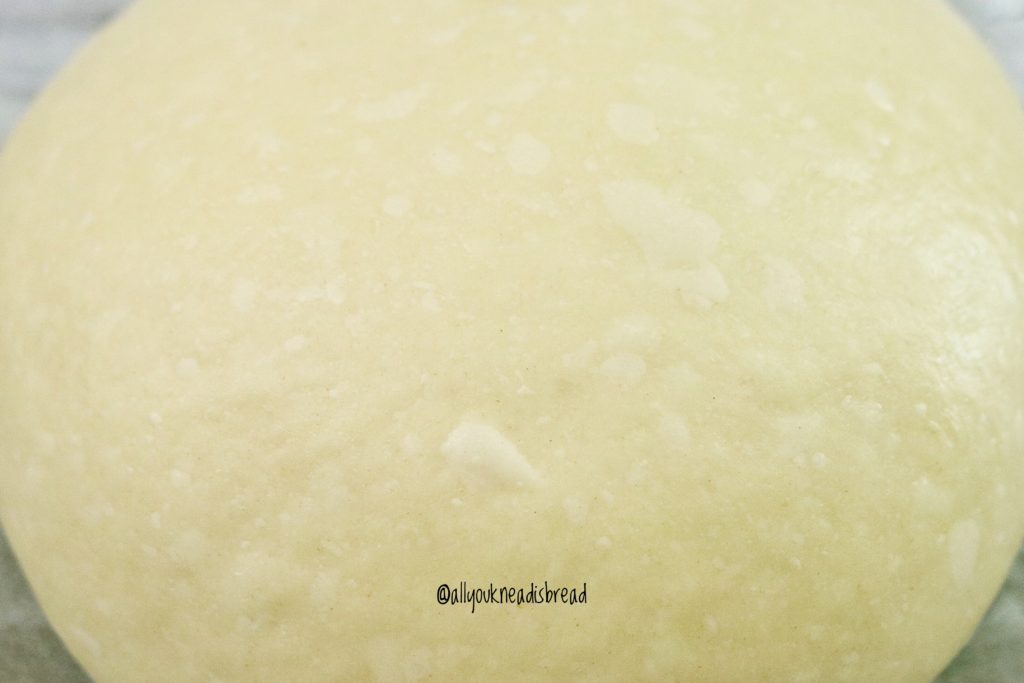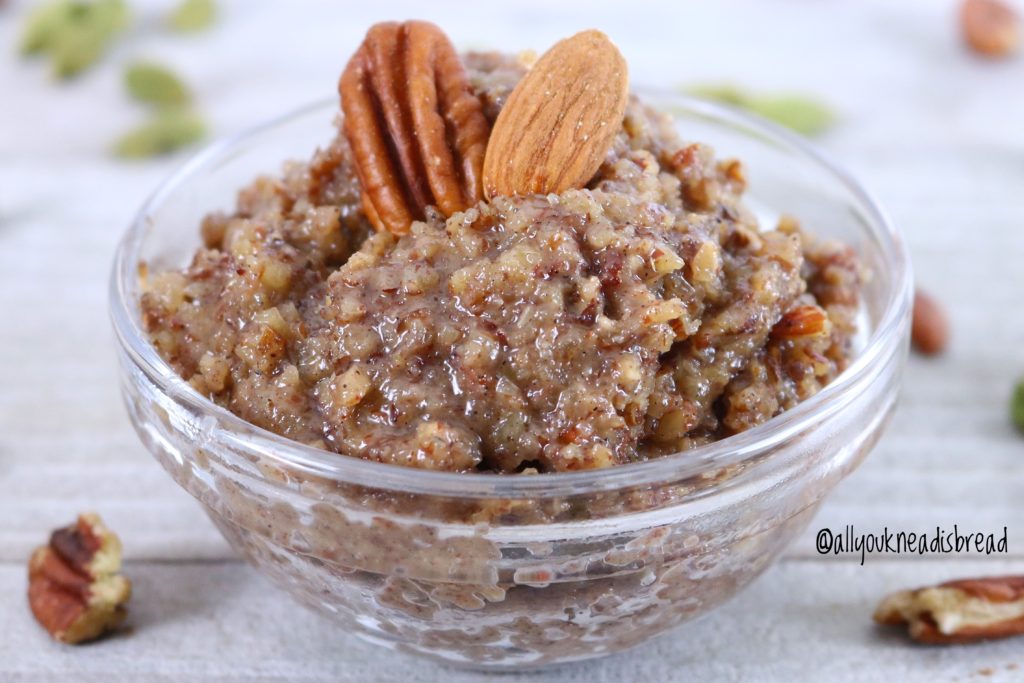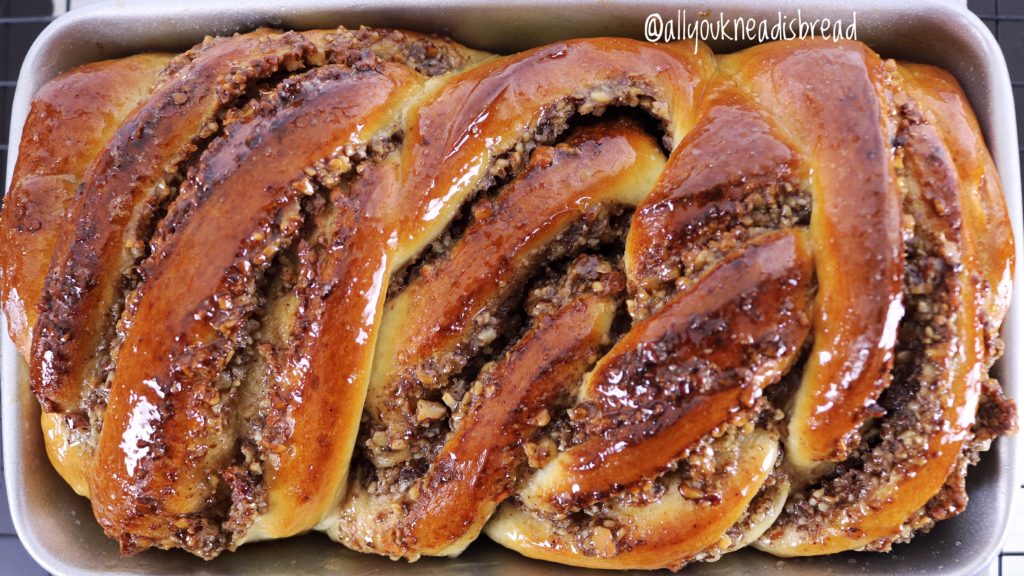It’s that time of the year again!
Fall is here and with it, all holidays and family & friends gatherings. Although, to be honest, sometimes I feel like I’m running out of ideas of what to bring to a party. Luckily for us all, I came up with a wonderful one!
Jump to Recipe
Babka!
You might think it’s not very original but this babka is different! I’ve developed a dough that keeps soft and fresh for many days, and a filling that’s unique and delicious! Oh, and also VERY customizable to fit everyone’s needs and preferences!
Nuts & cardamom babka!
In my opinion, babka is the perfect bread to play around with flavors and fillings. Firstly, because the dough it’s not too sweet and goes great with everything. Secondly, because it’s a beautiful bread!
Babka bread is a Polish Jewish bread (The non-Jewish babka is a cake rather than bread). The word “babka” comes from the Slavic word “babcia” which means “grandmother”.
Apparently, grandmas are worldwide known for making the yummiest food!
Babkas gained popularity after Polish people brought the recipe to New York City, and today is a very well known and loved sweet bread.
Although the original recipe called for a cinnamon filling, babka nowadays is made with plenty of other fillings, both sweet and savory.
On this recipe, I used pecans, hazelnuts, and almonds for the filling. I added cardamom powder and orange blossom water to make a paste with the ground nuts. And O EM GEE!
Note: You can find orange blossom water in Asian or Arabic stores. If you don’t live close to any, you can also find it on Amazon.
Okay, let’s talk nerdy for a minute!
One of the problems of bread (any bread) is shelf life. It dries out rather quickly (aka bread staling). However, when fats and sugar are added to the dough, the bread tends to last a bit longer because of how the fats and the gluten proteins attach to each other, and how the starch granules help give the gluten network elasticity and keep the moisture in the crumb. Okay, so what happens when we add nuts to the equation, especially when they are ground?
I’ve been thinking a lot about this, and although the dough ingredients and procedure definitely help, based on my reading and nerdy research, the oils in the nuts are released while cooking the paste, and during the baking process. The way babkas are shaped, they have several layers of filling. So, the layers of nut paste might stop the crumb moisture from leaving the bread so fast. Therefore, if it takes longer for the moisture to leave the bread, the bread will stay soft for longer time. Although I highly doubt this babka will last long!
There’s always a but…
But… adding nuts cannot make up for insufficient kneading. You still have to knead your dough well. The dough of this recipe is pretty sticky, but it does come together at the end. Check my brioche recipe to get directions on how to knead enriched dough.
You have to do it in batches. Knead a few minutes, let the dough rest a few minutes. You will see how after stopping for 5-10 minutes the dough is much more elastic and comes together much better. Don’t freak out if you spend a whole hour (with rests included) kneading. There’s nothing wrong with the dough. Eventually, it’ll become soft and elastic and shiny and it’ll have little blisters on the surface, and it won’t be sticky!
Never get intimidated by the time you spend kneading, it’s easier to not knead enough than to over work the dough.
Let’s start with this yummy recipe!
You can make this recipe with regular milk and butter, but I also tested a non-dairy version using soy milk and almond oil butter (it’s the one on the video) and it worked perfectly! If you use milk, just make sure you boil it first. Boiling the milk breaks down some enzymes that affect the development of the dough.
As always, activate the yeast first, then add the sugar and eggs and combine well.
Add the salt to the flour and mix the wet ingredients with the dry ingredients.
When you don’t see dry flour particles, cover the dough and let it rest a few minutes.
Start kneading and when you feel the dough is starting to get elastic add the butter or dairy-free spread.
I used Country Crock plant butter, the one with almond oil, and the dough turned out great! (Not an ad, I’m just letting you know what worked for my dairy free version ;] )
Incorporate the butter well and keep kneading. Let the dough rest as many times as you need, if you feel the dough is not coming together, stop, cover it, let it rest 5-10 mins and start again.

Avoid using too much flour while you knead, it will break the balance of the ingredients and your babka will end up drier. Trust in the power of gluten!
When the dough is elastic, it passes the windowpane test, it’s shiny and has blisters covering the surface it’s ready! You can stop kneading, shape it into a ball, and place it in a lightly oiled container.

Let the dough ferment until it is puffy and has risen about twice its volume. Then deflate the dough and let it rest a few minutes before dividing it into 2 equal pieces.
This recipe yields 2 loaves. So, while you work with one piece, make sure you cover the other piece of dough well. You can even place it in the fridge to slow down the fermentation.
While the dough is fermenting you can make the filling.
Grind the nuts thin enough they will make a paste. Add the cardamom powder, milk, and orange blossom water. If you want it sweeter you can add sugar too.
Cook at medium heat until the nuts get a paste-like consistency. Turn off the heat, add the butter and stir. The butter helps the paste be creamier.

Transfer the paste to a plate and let cool to room temperature. Remember that if you add the filling while it’s too hot you can kill the yeast.
When the dough has risen enough flour your work surface lightly and roll the dough into 12 x 17 in rectangle. You can roll it into a longer length, the thinner you roll it, the more layers your babka will have, but the slices will fall apart easier.
Spread the filling on the dough and roll it into a log. Cut the log lengthwise and twist both strands leaving the open part up.
Grease your baking pan and place the babka in it. Let it rise until it reaches the edges of the pan.

Before the fermentation time ends, turn your oven on at 335F
Brush the babka with the leftover egg white and bake until it’s golden brown (about 45 mins, it depends on your oven). If the babka is not dark enough, you can bake it 5 minutes at 350F but be careful, the top can burn quickly!
After baking, babka is usually brushed with a simple syrup
If you want to make the syrup mix 2 tbsp of water and 2 tbsp of sugar and bring it to a boil. Cook until it reaches syrup consistency.
If you don’t want to make the syrup, I found a shortcut: Maple syrup!
Mix 2 tbsp of maple syrup and 2 tsp of water and mix very well.
When your babka is cooked, brush it with the syrup immediately, you can even pour the leftover syrup through the gaps. This will also help keep the moisture in the loaf.

Let the babka cool down a few minutes in the pan an then transfer it to a cooling rack to cool completely… If you can wait that long!
The next step is to make a nice cappuccino an enjoy it with a slice of your babka!

Let me know what you think if you make this recipe and don’t forget to subscribe to my YouTube channel so you can receive a notification when I upload a video!
Enjoy!

Nuts and Cardamom Babka
Ingredients
Dough
- 500 g bread flour
- 225 g milk or vegetable milk
- 5 g dry yeast
- 80 g butter or dairy-free spread
- 2 L eggs
- 1 L egg yolk
- 50 g granulated white sugar
- 6 g salt
- 2 tsp vanilla extract
Filling (1 loaf)
- 200 g assorted nuts
- 70-100 g milk or vegetable milk
- 30 g sugar (optional)
- 2 tsp ground cardamom
- 2 tbsp orange blossom water
- 10 g butter or dairy-free spread (optional)
Instructions
Dough
-
Add the yeast to the lesser amount of milk and let it sit for 1o minutes to activate the yeast
-
Add the sugar, eggs, and vanilla extract and mix well
-
On a separate bowl sift the flour and add the salt
-
Add the flour to the wet ingredients, combine until you don't see dry flour particles, and let it rest 20-30 mins (autolysis)
-
Knead the dough until it's elastic, shiny and covered with small blisters. It should pass the windowpane test.
-
Let the dough ferment until it doubles in size and it's puffy
-
Deflate the dough well and divide it in 2 equal pieces
-
Roll one piece into a 12 x 17 in a rectangle. Spread the filling and roll the dough into a log
-
Cut the log lengthwise and twist each strand
-
Grease a 9in loaf pan and place the babka inside. Let it proof until the dough reaches the edges of the pan
-
Turn your oven on at 335F
-
Brush the babka with the leftover egg white and bake it for 45 minutes or until is golden brown
-
Prepare the syrup and brush it on the babka immediately after you take it out of the oven.
Filling
-
Grind the nuts in a food processor
-
Add the cardamom and sugar if you're adding any and stir well
-
Add the milk and orange blossom water and combine everything
-
Cook the nuts at medium heat until it gets a paste consistency
-
Add the butter for a creamier paste
-
Transfer to a plate and let it cool down to room temperature

I am so excited to try this recipe!! I just stumbled across your blog yesterday and I have to say that I am beyond thrilled that you are taking the time to explain the scientific workings behind the miracle that is bread, and I have been hooked reading recipe after recipe!
I’m an avid bread maker and I was frustrated with the ‘on the surface’ advice that most recipes provide, so your blog is a goldmine for me!
One question though, I read through your recipe for panettone (my next project once I get my hands on some wheat gluten) and the adding of the gluten for more height and structure intrigued me! I have been trying for aaaaages to get the height and spring that I find in breads purchased from artisan bakeries,but never quite succeeded.
Ok so back to my question, can I add a tbsp of wheat gluten to this babka recipe for more structure? The ones I’ve tried baking were always more cake like, even with bread flour, and I would like it to be more bready.
Again, thanks so much!!
Hello! So glad to find another bread nerd here! hehehe.
If your flour is not strong enough, by all means, try adding more gluten and see if that works for you! My flour has 12.7% protein, it’s fairly strong bread flour. If you add more gluten make sure the consistency of your dough is correct, as you might need to add a bit more liquid. Whatever you do, knead the dough until you have a good windowpane. Even if you have to let it rest every few minutes at a time. When you have an elastic dough and proper fermentation, the result is more pillowy and bread-like.
For traditional panettone, the one made with pasta madre, the flour used is very strong and with very particular specs. My panettone recipe is a yeasted one, not the traditional, but I think it’s a good way to start working with more enriched dough 🙂 hope this helps!